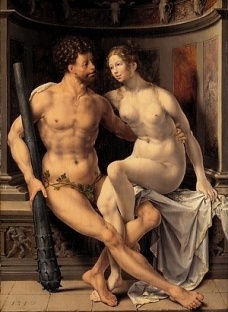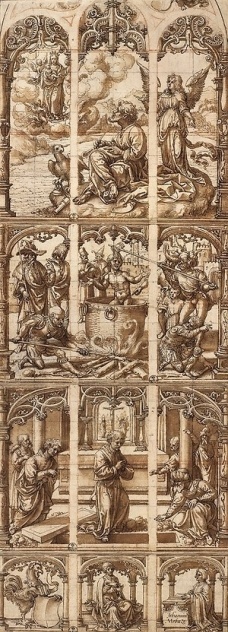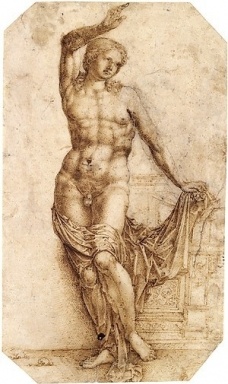
newspaper
agenda cultural
me of the most important contributions to the exhibition and catalogue will include technical examinations of Gossart's paintings that curator Maryan Ainsworth has undertaken in collaboration with colleagues at many museums over the last three years
The first major exhibition in 45 years devoted to Jan Gossart (ca. 1478-1532)- one of the most innovative artists of the Burgundian-Habsburg Netherlands—will be on view at The Metropolitan Museum of Art beginning October 6, 2010. Man, Myth, and Sensual Pleasures: Jan Gossart's Renaissance will bring together the majority of Gossart's paintings, drawings, and prints, and place them in the context of the influences on his transformation from Late Gothic Mannerism to the new Renaissance mode. Gossart was among the first northern artists to travel to Rome to make copies after antique sculpture and monuments and to introduce biblical and mythological subjects with erotic nude figures into the mainstream of northern painting. Most often credited with successfully assimilating Italian Renaissance style into northern European art of the early 16th century, he is the pivotal Old Master who redirected the course of early Flemish painting from the legacy of its founder, Jan van Eyck, and charted new territory that eventually led to the great age of Rubens.
The exhibition is made possible by the William Randolph Hearst Foundation, the Gail and Parker Gilbert Fund, Flanders House New York, and the Society of Friends of Belgium in America.
Additional support is provided by The Horace W. Goldsmith Foundation, Hester Diamond, David Kowitz, the Samuel H. Kress Foundation, and Joyce P. and Diego R. Visceglia.
The exhibition was organized by The Metropolitan Museum of Art, New York, in association with The National Gallery, London.
It is supported by an indemnity from the Federal Council on the Arts and the Humanities.
Jan Gossart has not been the focus of a monographic exhibition since 1965 (in Rotterdam and Bruges) and has never before been the subject of an exhibition in the United States. Man, Myth, and Sensual Pleasures: Jan Gossart's Renaissance will be divided into eight sections and will comprise approximately 145 works, including 50 of the artist's 63 known paintings, 35 drawings, and six prints from U.S. and international collections. In order to consider Gossart within his artistic milieu, other works on view will include antique and Renaissance sculpture, paintings by contemporaries Gerard David and Bernard van Orley, and prints and drawings by artists such as Marcantonio Raimondi, Dirk Vellert, Lucas van Leyden, Albrecht Dürer, and Jacopo de'Barbari. A number of works in the exhibition have been borrowed from various curatorial departments at the Metropolitan Museum, such as European Sculpture and Decorative Arts, Drawings and Prints, the Lehman Collection, and Greek and Roman Art.
Among the many highlights from Gossart's oeuvre in the exhibition will be the Virgin and Child with Musical Angels and Saints Catherine and Dorothy (Malvagna Triptych), an exquisite gem-like altarpiece that is Gossart's only surviving intact triptych, on rare loan from the Galleria Regionale della Sicilia in Palermo, Italy; the stunning Saint Luke Drawing the Virgin from the Kunsthistorisches Museum in Vienna; the magnificent Deesis panel on exceptional loan from the Prado; the Carondelet Diptych,, considered one of the masterpieces of early Netherlandish portraiture, from the Musée du Louvre; the Elderly Couple, an astonishing study of old age painted on parchment from the National Gallery in London; and Portrait of a Man (Jan Jacobsz. Snoeck?), a remarkably well-preserved painting from the National Gallery of Art, Washington, D.C., that represents the peak of Gossart's artistic achievement.
About the Artist Gossart was born in Maubeuge, today in Northern France, in about 1478. Mabuse is the Dutch name for Maubeuge, and thus developed the sobriquet of the artist. Nothing is known about where Jan Gossart or "Mabuse" trained as a painter, but documents verify that he became a member of the painters' Guild in Antwerp in 1503. From 1508-1509, Gossart traveled to Rome with the important court diplomat Philip of Burgundy, who was an envoy to Pope Julius II at the Vatican on behalf of Margaret of Austria, Regent of the Netherlands. Influenced by the antique and modern Italian art that he encountered on his sojourn in Rome, he became a key adherent and promoter of the art of biblical and mythological subjects represented by nude figures. For northern painters and their patrons rooted in the traditional manner and themes of the late Gothic period, the new style that Gossart brought back from Rome must have appeared shockingly avant-garde; and for the Humanists of the time, Gossart was perhaps the first truly
Renaissance painter or "Romanist" in the north.
Upon his return from Rome, Gossart settled in Middleburg, but apparently also spent time in Bruges working with Gerard David (ca. 1455-1523), the city's leading painter. The nature of this collaboration has not been previously recognized, but the technical examination of several of the paintings recently undertaken for this exhibition has helped to clarify the specific relationship between Gossart and David. Gossart also produced large- and small-scale works of mythological themes with thinly veiled erotic content (a number of which will be on view) at the request of his patron, Philip of Burgundy. The impact of the lessons he learned in Rome as well as a friendship with the court sculptor, Conrad Meit, led Gossart to pursue an increasingly sculptural exploration of the human body in his works and the relationship of figures to each other.
Gossart's extraordinary technique and execution, as well as his novel approach to both traditional and new themes in his art, made for a particularly successful career. He received commissions from some of the most noted patrons of his day, including Philip of Burgundy, Margaret of Austria, Christian II of Denmark, and Henry of Nassau and his wife Mencía de Mendoza.

Jan Gossart (Netherlandish, ca. 1478–1532). Hercules and Deianira, 1517. Oil on panel Barber Institute of Fine Arts, University of Birmingham

Jan Gossart (Netherlandish, ca. 1478–1532). Design for a Glass Window with Scenes from the Life of Saint John the Evangelist, ca. 1520s. Pen and brown ink, brown wash, red chalk, squared for transfer in black chalk. Gabinetto Disegni e Stampe degli Uffizi

Jan Gossart (Netherlandish, ca. 1478–1532). The Apollo Citharoedus of the Casa Sassi, 1509. Pen and brown ink, over black chalk. Gallerie dell'Accademia, Venice

